The first-generation Ford Mustang was manufactured by Ford from March 1964 until 1973. The introduction of the Mustang created a new class of automobile known as the pony car. The Mustang’s styling, with its long hood and short deck, proved wildly popular and inspired a host of imitators.
It was initially introduced as a hardtop and convertible with the fastback version put on sale in August 1965. At the time of its introduction, the Mustang, sharing its underpinnings with the Falcon, was slotted into a compact car segment.
With each revision, the Mustang saw an increase in overall dimensions and in engine power. The 1971 model saw a drastic redesign to its predecessors. After an initial surge, sales were steadily declining, as Ford began working on a new generation Mustang. With the onset of the 1973 oil crisis, Ford was prepared, having already designed the smaller Mustang II for the 1974model year. This new car had no common components with preceding models.
Conception and styling
As Lee Iacocca's assistant general manager and chief engineer, Donald N. Frey was the head engineer for the Mustang project — supervising the development of the Mustang in a record 18 months from September 1962 to March 1964. — while Iacocca himself championed the project as Ford Division general manager.
Drawing on inspiration from the mid-engined Ford Mustang I concept vehicle, Lee Iacocca ordered development of a new "small car"to vice-president of design at Ford,Eugene Bordinat. Bordinat tasked Ford's three design studios (Ford, Lincoln-Mercury, and Advanced Design) to create proposals for the new vehicle.
The design teams had been given five goals for the design of the Mustang: It would seat four, have bucket seats and a floor mounted shifter, weigh no more than 2,500 pounds (1,100 kg) and be no more than 180 inches (4,572 mm) in length, sell for less than $2,500, and have multiple power, comfort, and luxury options.
The Lincoln–Mercury design studio ultimately produced the winning design in the intramural contest, under Project Design Chief Joe Oros and his team of L. David Ash, Gale Halderman, and John Foster.
In a 2004 interview, Oros recalls the planning behind the design:
| “ | I told the team that I wanted the car to appeal to women, but I wanted men to desire it, too. I wanted a Ferrari-like front end, the motif centered on the front – something heavy-looking like a Maseratti , but, please, not a trident – and I wanted air intakes on the side to cool the rear brakes. I said it should be as sporty as possible and look like it was related to European design. | ” |
Oros added:
| “ | I then called a meeting with all the Ford studio designers. We talked about the sporty car for most of that afternoon, setting parameters for what it should look like -- and what it should not look like -- by making lists on a large pad, a technique I adapted from the management seminar. We taped the lists up all around the studio to keep ourselves on track. We also had photographs of all the previous sporty cars that had been done in the Corporate Advanced studio as a guide to themes or ideas that were tired or not acceptable to management.
Within a week we had hammered out a new design. We cut templates and fitted them to the clay model that had been started. We cut right into it, adding or deleting clay to accommodate our new theme, so it wasn't like starting all over. But we knew Lincoln-Mercury would have two models. And Advanced would have five, some they had previously shown and modified, plus a couple extras. But we would only have one model because Ford studio had a production schedule for a good many facelifts and other projects. We couldn't afford the manpower, but we made up for lost time by working around the clock so our model would be ready for the management review.
| ” |
L. David Ash is often credited with the actual styling of the Mustang. Ash, in a 1985 interview speaking of the origin of the Mustang design, when asked the degree of his contribution, said:
| “ | I would say substantial. However, anyone that says they designed the car by themselves, is wrong. Iacocca didn't design it. He conceived it. He's called the father of it, and, in that respect, he was. I did not design it in total, nor did Oros. It was designed by a design group. You look at the photograph taken at the award banquet for the Industrial Designers’ Society where the Mustang received the medal; it’s got Damon Woods in it (the group that did the interior), and Charlie Phaneuf (who was with Damon), and it’s got myself and John Foster (who was with me), it’s got (John) Najjar in it. | ” |
| “ | So nobody actually did the car, as such. Iacocca in his book flat out comes and says I did the car. It's right there in print, "It's Dave Ash's Mustang." Bordinat will tell you I did the car. This book tells you I did the car, but, in actual fact, I had a lot of help, and I don't think anyone ever does a car by himself, not in these times anyway. | ” |
Gale Haldeman, in a 2002 interview with Collectible Automobile, spoke of the Mustang's evolution through the Lincoln-Mercury studio:
| “ | Dave Ash had started a clay model of the car. He had this very boxy, very stiff-looking car. Joe came back from a management conference, saw it, and said, "No, no, no, we're not going to do that!" That's when he came to me....he said, "...we've just been given an assignment by Bordinat to do a proposal on a small car that Lee [Iaccoca] wants to build. We've got to do one, and I want you to work on that project." I went home and sketched some cars, and I took about five or six sketches with me the next morning and put them up on the board. | ” |
| “ | We must have put 25 sketches on the board that morning, because Joe assigned three or four of us to do designs. Joe picked one of the sketches I did at home to be clay modeled....so we actually started over on [Dave Ash's] clay model with the theme from one of my designs, which had scoops on the sides and the hop-up quarter lines. | ” |
To decrease developmental costs, the Mustang used chassis, suspension, and drivetrain components derived from the Ford Falcon and Fairlane. It used a unitized platform-type frame from the 1964 Falcon, and welded box-section side rails, including welded crossmembers. Although hardtop Mustangs accounted for the highest sales, durability problems with the new frame led to the engineering of a convertible first, which ensured adequate stiffness. Overall length of the Mustang and Falcon was identical, although the Mustang's wheelbase was slightly shorter. With an overall width of 68.2 in (1,732 mm), it was 2.4 in (61 mm) narrower, yet the wheel track was nearly identical. Shipping weight, approximately 2,570 lb (1,166 kg) with the straight six-cylinder engine, was also similar to the Falcon. A fully equipped V8 model weighed approximately 3,000 lb (1,361 kg). Although most of the mechanical parts were from the Falcon, the Mustang's body was completely different; sporting a shorter wheelbase, wider track, lower seating position and lower overall height. An industry first, the "torque box" was an innovative structural system that greatly stiffened the Mustang's construction and helped contribute to better handling.
Gale Haldeman spoke of the engineering and design of the car in his interview, stating:
| “ | No one knew the Mustang was going to be as popular as it was, but it created a huge stir in the company. Everybody just loved it, even the engineers, though we must have bent 75 in-house engineering and manufacturing rules. The Mustang had the first floating bumpers. The whole front end was a die-casting with a floating hood. | ” |
| “ | There were so many things the engineers said we shouldn't be doing, but they didn't want to change them either. There was so much enthusiasm right from the beginning. Even the drivers at the test track loved it. We would go there for meetings, and the crowds of people around it were huge. That was totally unusual, so we suspected the Mustang was going to be a hit. | ” |
The idea for a fastback originated with Joe Oros as well, and was designed in Charlie Phaneuf's studio. Haldeman recalls as follows:
| “ | We did it in secret. No one, including Sperlich or Iacocca, saw it until it was finished. We cast it in fiberglass, painted it bright red, and then showed it to Iacocca. He said, "We've got to do it!" | ” |
An additional 4-door model was designed by Dave Ash as a clay model, but was not considered.
1964–1966
Since it was introduced five months before the normal start of the 1965 production year and manufactured alongside 1964 Ford Falcons and 1964 Mercury Comets, the earliest Mustangs are widely referred to as the 1964½ model. Nevertheless, all "1964½" cars were given 1965 U.S. federal VIN numbers at the time of production, and - with limited exception to the earliest of promotional materials - were marketed by Ford as 1965 models. The low-end model hardtop used a "U-code" 170 cu in(2.8 L) straight-6 engine borrowed from the Falcon, as well as a three-speed manual transmission and retailed for US$2,368. Standard equipment for the early 1965 Mustangs included black front seat belts, a glove box light, and a padded dash board. Production began in March 1964 and official introduction following on April 17 at the 1964 World's Fair.
Several changes to the Mustang occurred at the start of the normal 1965 model year production, five months after its introduction. These cars are known as "late 65's," and were built after factory retooling in August 1964. The engine lineup was changed, with a 200 cu in (3.3 L) "T-code" engine that produced 120 hp (89 kW; 122 PS). Production of the "F-code" 260 cu in (4.3 L) engine ceased when the 1964 model year ended. It was replaced with a new 200 hp (150 kW) "C-code" 289 cu in (4.7 L) engine with a two-barrel carburetor as the base V8. An "A-code" 225 hp (168 kW; 228 PS) four-barrel carbureted version was next in line, followed by the unchanged "Hi-Po" "K-code" 271 hp (202 kW; 275 PS) 289. The DC electrical generator was replaced by a new AC alternator on all Fords (a way to distinguish a 1964 from a 1965 is to see if the alternator light on the dash says "GEN" or "ALT"). The Mustang GT version was introduced as the "GT Equipment Package" and included a V8 engine(most often the 225 hp (168 kW; 228 PS) 289), grille-mounted fog lamps, rocker panel stripes, and disc brakes. In the interior the GT option added a different instrument panel that included a speedometer, fuel gauge, temp. gauge, oil pressure gauge and ammeter in five round dials (the gauges were not marked with numbers, however.) A four-barrel carbureted engine was now available with any body style. Additionally, reverse lights were an option added to the car from August 1964 production. The Mustang was originally available as either a hardtop or convertible, but during the car's early design phases a fastback model was strongly considered. In 1965, the Shelby Mustang was born, it was available only in newly introduced fastback body version with its swept-back rear glass and distinctive ventilation louvers.
The standard interior features of the 1965 Mustang included adjustable driver and passenger bucket seats, an AM radio, and a floor mounted shifter in a variety of color options. Ford added additional interior options during the 1965 model year. The Interior Decor Group was popularly known as "Pony Interior" due to the addition of embossed running ponies on the seat fronts, and also included integral armrests, woodgrain appliqué accents, and a round gauge cluster that would replace the standard Falconinstrumentation. Also available were sun visors, a (mechanical) remote-operated mirror, a floor console, and a bench seat. Ford later offered an under-dash air-conditioning unit, and discontinued the vinyl with cloth insert seat option, offered only in early 1965 models. One option designed strictly for fun was the Rally-Pac. Introduced in 1963 after Ford's success at that year'sMonte Carlo Rally and available on other Ford and Mercury compacts and intermediates, the Rally-Pac was a combination clock and tachometer mounted to the steering column. It was available as a factory ordered item for US$69.30. Installed by a dealer, the Rally-Pac cost US$75.95.A 14" rim option was available for Rally-pac and GT350R vehicles widening front and rear track to 57.5". Reproductions are presently available from any number of Mustang restoration parts sources. A compass, rear seat belts, A/C, and back-up lights were also optional.
Nationwide survey of owners by Popular Mechanics included many complaints about leg room. Fuel economy was very good for the period, with a published test by Popular Mechanics rating the small 260 cubic inch V8 with automatic transmission at 20.93 mpg at 60 mph.
The 1966 Mustang debuted with moderate trim changes including a new grille, side ornamentation, wheel covers and gas cap. Ford's new C-4 "cruise-o-matic" three-speed auto transmission became available for the 225 hp V8. The 289 "HiPo" K-code engine was also offered with a c4 transmission, but it had stronger internals and can be identified by the outer casing of the servo which is marked with a 'C'. The long duration solid-lifter camshaft that allowed the high revving 289 to make the horsepower it was known for, was not friendly for a low stall speed automatic torque converter. The "HiPo" could be spotted very easily by the 1-inch-thick (25 mm) vibration damper, (as compared to 1/2 inch on the 225-hp version) and the absence of a vacuum advance unit on the dual point distributor. With the valve covers off, there is a large letter "K" stamped between the valve springs, that along with screw in studs (vs. a pressed in stud for other 289s) for the adjustable rocker arms. A large number of new paint and interior color options, anAM/eight-track sound system, and one of the first AM/FM mono automobile radios was also offered. It also removed the Falcon instrument cluster; the previously optional features, including the round gauges and padded sun visors, became standard equipment. The Mustang convertible would be the best-selling in 1966, with 72,119 sold, beating the number two Impala by almost 2:1.
The 1965 and 1966 Mustangs are differentiated by variations in the exterior, despite similar design. These variations include the emblem on the quarter-panels behind the doors. From August 1964 production, the emblem was a single vertical piece of chrome, while for 1966 models the emblem was smaller in height and had three horizontal bars extending from the design, resembling an "E". The front intake grilles and ornaments were also different. The 1965 front grille used a "honeycomb" pattern, while the 1966 version was a "slotted" style. While both model years used the "Horse and Corral" emblem on the grille, the 1965 had four bars extending from each side of the corral, while on the 1966, these bars were removed. The 1966 model year saw introduction of 'High Country Special' limited edition, 333 of them were sold in Colorado, Wyoming, and Nebraska.
When Ford wanted to introduce the Mustang in Germany, they discovered that Krupp company had already registered the name for a truck. The German company offered to sell the rights for US$10,000. Ford refused and removed Mustang badges from exported units, instead naming the cars as T-5 (a pre-production Mustang project name) for the German market until 1979 when Krupp copyrights expired.
1965 Mustang AWD Prototype
In 1965, Harry Ferguson Research purchased 3 Mustang notchbacks and converted them to 4x4 in an attempt to sell potential clients on their FF AWD system. A similar system was used in the Ferguson P99 Formula One car, and would go on to be featured in the Jensen FF, widely considered the first AWD passenger car. As in the Jensen FF, the AWD Mustangs also featured an ABS braking system, long before such a feature was commonplace.
|
Engines
| engine displacement, type, carburetor type | max. motive power at rpm | max. torque at rpm |
|---|---|---|
| 170 cu in (2.8 L) Thriftpower I6 (1964) 1-barrel | 105 bhp (78 kW; 106 PS) @ 4,400 | 156 lb·ft (212 N·m) @ 2,400 |
| 200 cu in (3.3 L) Thriftpower I6 (1965–1966) 1-barrel | 120 bhp (89 kW; 122 PS) @ 4,400 | 190 lb·ft (258 N·m) @ 2,400 |
| 260 cu in (4.3 L) Windsor V8 (1964) 2-barrel | 164 bhp (122 kW; 166 PS) @ 4,400 | 258 lb·ft (350 N·m) @ 2,200 |
| 289 cu in (4.7 L) Windsor V8 (1965–1966) 2-barrel | 200 bhp (149 kW; 203 PS) @ 4,400 | 282 lb·ft (382 N·m) @ 2,400 |
| 289 cu in (4.7 L) Windsor V8 (1964) 4-barrel | 210 bhp (157 kW; 213 PS) @ 4,400 | 300 lb·ft (407 N·m) @ 2,800 |
| 289 cu in (4.7 L) Windsor V8 (1965–1966) 4-barrel | 225 bhp (168 kW; 228 PS) @ 4,800 | 305 lb·ft (414 N·m) @ 3,200 |
| 289 cu in (4.7 L) Windsor HiPo V8 (1964–1966) 4-barrel | 271 bhp (202 kW; 275 PS) @ 6,000 | 312 lb·ft (423 N·m) @ 3,400 |
1967–1968
The 1967 model year Mustang was the first redesign of the original model. Ford's designers began drawing up a larger version even as the original was achieving sales success, and while "Iacocca later complained about the Mustang's growth, he did oversee the redesign for 1967 ." The major mechanical feature was to allow the installation of a big-block V8 engine. The overall size, interior and cargo space were increased. Exterior trim changes included concave taillights, side scoop (1967 model) and chrome (1968 model) side ornamentation, square rear-view mirrors, and usual yearly wheel and gas cap changes. The high-performance 289 option was placed behind the newer 335 hp (250 kW; 340 PS) 390 cu in (6.4 L) FE engine from the Ford Thunderbird, which was equipped with a four-barrel carburetor. A 390 GT engine, and a 4-speed manual transmission recordedquarter mile times of approximately 13 seconds and trap speeds of over 105 mph (169 km/h) During the mid-1968 model year, a drag racer for the street could be ordered with the optional 428 cu in (7.0 L) Cobra Jet engine which was officially rated at 335 hp (250 kW; 340 PS) all of these Mustangs were issued R codes on their VIN#'s.
The 1967 Deluxe Interior was revised, discontinuing the embossed running horse motif on the seat backs (the source for the "pony interior" nickname) in favor of a new deluxe interior package, which included special color options, brushed aluminum (from 8/1966 production) or woodgrain dash trim, seat buttons, and special door panels. The hardtop also included upholstered quarter trim panels, a carryover from the 65-66 deluxe interior. The 67 hardtop also had the chrome quarter trim caps, carried over from 65-66, but these were painted to match the interior in 1968 models. The 1967 deluxe interior included stainless steel-trimmed seat back shells, similar to those in the Thunderbird. These were dropped at the end of the 67 model year, and were not included in the woodgrain-trimmed 1968 interior. The deluxe steering wheel, which had been included in the deluxe interior for the 65-66, became optional, and could also be ordered with the standard interior. The 1968 models that were produced from January 1968 were also the first model year to incorporate 3 point lap and shoulder belts (which had previously been optional, in 67-68 models) as opposed to the standard lap belts. The air-conditioning option was fully integrated into the dash, the speakers and stereo were upgraded, and unique center and overhead consoles were options. The fastback model offered the option of a rear fold-down seat, and the convertible was available with folding glass windows. Gone too was the Rally-Pac, since the new instrument cluster had provisions for an optional tachometer and clock. Its size and shape also precluded the installation of the accessory atop the steering column. The convenience group with four warning lights for low fuel, seat belt reminder, parking brake not released, and door ajar were added to the instrument panel, or, if one ordered the optional console and A/C, the lights were mounted on the console.
Changes for the 1968 model increased safety with a two-spoke energy-absorbing steering wheel, along with newly introduced shoulder belts. Other changes included front and rear side markers, "FORD" lettering removed from hood, rearview mirror moved from frame to windshield, a 302 cu in (4.9 L) V8 engine was now available, and C-Stripe graphics were added.
The California Special Mustang, or GT/CS, was visually based on the Shelby model and was only sold in Western states. Its sister, the 'High Country Special', was sold in Denver, Colorado. While the GT/CS was only available as a coupe, the 'High Country Special' model was available in fastback and convertible configurations during the 1966 and 1967 model years, and as a coupe for 1968.
The 1968 Ford Mustang GT Fastback reached iconic status after it was featured in the 1968 film Bullitt, starring Steve McQueen. In the film, McQueen drove a modified 1968 Mustang GT 2+2 Fastback. Two vehicles were used in the filming of the movie and only one is still in existence today.
|
Engines
| engine displacement, type, carburetor type | max. motive power at rpm | max. torque at rpm |
|---|---|---|
| 200 cu in (3.3 L) Thriftpower I6 (1968) 1-barrel | 115 bhp (86 kW; 117 PS) @ 4,400 | 190 lb·ft (258 N·m) @ 2,400 |
| 200 cu in (3.3 L) Thriftpower I6 (1967) 1-barrel | 120 bhp (89 kW; 122 PS) @ 4,400 | 190 lb·ft (258 N·m) @ 2,400 |
| 289 cu in (4.7 L) Windsor V8 (1968) 2-barrel | 195 bhp (145 kW; 198 PS) @ 4,600 | 288 lb·ft (390 N·m) @ 2,600 |
| 289 cu in (4.7 L) Windsor V8 (1967) 2-barrel | 200 bhp (149 kW; 203 PS) @ 4,400 | 282 lb·ft (382 N·m) @ 2,400 |
| 302 cu in (4.9 L) Windsor V8 (1968) 2-barrel | 210 bhp (157 kW; 213 PS) @ 4,600 | 300 lb·ft (407 N·m) @ 2,600 |
| 289 cu in (4.7 L) Windsor V8 (1967) 4-barrel | 225 bhp (168 kW; 228 PS) @ 4,800 | 305 lb·ft (414 N·m) @ 3,200 |
| 302 cu in (4.9 L) Windsor V8 (1968) 4-barrel | 230 bhp (172 kW; 233 PS) @ 4,800 | 310 lb·ft (420 N·m) @ 2,800 |
| 289 cu in (4.7 L) Windsor HiPo V8 (1967) 4-barrel | 271 bhp (202 kW; 275 PS) @ 6,000 | 312 lb·ft (423 N·m) @ 3,400 |
| 390 cu in (6.4 L) FE V8 (1968) 2-barrel | 270 bhp (201 kW; 274 PS) @ 4,400 | 401 lb·ft (544 N·m) @ 2,600 |
| 390 cu in (6.4 L) FE V8 (1967) 4-barrel | 320 bhp (239 kW; 324 PS) @ 4,800 | 427 lb·ft (579 N·m) @ 3,200 |
| 390 cu in (6.4 L) FE V8 (1968) 4-barrel | 325 bhp (242 kW; 330 PS) @ 4,800 | 427 lb·ft (579 N·m) @ 3,200 |
| 390 cu in (6.4 L) FE V8 (1969) 4-barrel | 320 bhp (239 kW; 324 PS) @ 4,600 | 427 lb·ft (579 N·m) @ 3,200 |
| 428 cu in (7.0 L) Cobra Jet V8 (1968) 4-barrel | 335 bhp (250 kW; 340 PS) @ 5,200 | 440 lb·ft (597 N·m) @ 3,400 |
1969–1970
The 1969 model year restyle "added more heft to the body" with body length extended by 3.8 inches (97 mm) (the wheelbase remaining at 108 inches), width increased by almost half an inch, and the Mustang's "weight went up markedly too." 1969 was the first model to use quad headlamps placed both inside and outside the grille opening. The corralled grille pony was replaced with the pony and tribars logo, set off-center to the drivers side. The car was longer than previous models and sported convex rather than concave side panels. The fastback body version was renamed Sportsroof, styled as SportsRoof in Ford's literature.
The 1969 model year saw the introduction of the Mach 1, with a variety of powerplants options and many new styling and performance features. Distinctive reflective striping was placed along the body sides, with a pop-open gas cap, dual exhausts, matte-black hood with simulated air scoop and NASCAR-style cable and pin tiedowns. It used steel wheels with bold-letteredGoodyear Polyglas tires. A functional "shaker" hood scoop - which visibly vibrated by being attached directly to the air cleaner through a hole in the hood - was available, as were tail-mounted wing and chin spoilers and rear window louvered blackout shade. The Mach 1 featured a deluxe interior with simulated wood trim, high backed seats, extra sound deadening, remote sports mirrors and other comforts. The Mach 1 proved popular with buyers with 72,458 cars sold through 1969.
The Boss 302 was created to meet Trans Am rules and featured distinctive hockey-stick stripes, while the understated Boss 429was created to homologate the Boss 429 engine (based on the new Ford 385 series engine) for NASCAR use. The two Boss models received fame on the track and street and to this day they still demand premium pricing for their pedigree. 1628 Boss 302's and 859 Boss 429's were sold through 1969 - making these vehicles somewhat rare.
A new "luxury" model became available starting for 1969, available in only the hardtop body style. The 'Grande' featured a soft ride, 55 pounds (24.9 kg) of extra sound deadening, as well as deluxe interior with simulated wood trim. It was popular with buyers with 22182 units sold through 1969.
Amidst other special editions, the 1969 Mustang E was offered for those desiring high mpg. The 1969 Limited Edition Mustang E was a rare (about 50 produced) fastback special model designed for economy. It came with a six-cylinder engine (250 cu in (4.1 L)), a high stall torque converter for the standard automatic transmission and a very low, 2.33:1 rear axle ratio. Mustang E lettering on the rear quarters identified the special Mustang E. Air conditioning was not available on the 'E' model.
The Mustang GT was discontinued in 1969 due to poor sales versus the success of the new Mach 1 with only 5396 GT models sold that year.
A new 250 cu in (4.1 L) Thriftpower I6 engine with 155 hp (116 kW; 157 PS) filled the gap between the existing 200 cu in (3.3 L) Thriftpower I6 and the V8 engine line-up.
Although 1969 continued with many of the same basic V8 engines available on 1968 models, notably a now revised 302 cu in (4.9 L) Windsor engine with 220 hp (164 kW; 223 PS), the 390 cu in (6.4 L) FE with 320 hp (239 kW; 324 PS) and the recently launched 428 cu in (7.0 L) Cobra Jet engine (with or without Ram-Air) with an advertised 335 hp (250 kW; 340 PS), a variety of revised options and changes were introduced to keep the Mustang fresh and competitive including a new performance V8 available in 250 hp (186 kW; 253 PS) or 290 hp (216 kW; 294 PS) tune known as the 351 cu in (5.8 L) Windsor (351W), which was effectively a stretched and revised 302 cu in (4.9 L) to achieve the extra stroke.
The 428 cu in (7.0 L) Cobra Jet engine continued unchanged in the 1969 and 1970 model years and continued to be advertised at just 335 hp (250 kW; 340 PS) despite being closer to 410 hp (306 kW; 416 PS). However, whenever a V or W axle was ordered (3.90 or 4.30 locking ratio) on any Cobra Jet Mustang, this kicked in various engine improvements which were designed to make the engine more reliable on the strip. These improvements included an engine oil cooler (which resulted in AC not remaining an option), stronger crankshaft and conrods and improved engine balancing and was named the 'Super Cobra Jet'. On the order form, these improvements were later referred to as 'Drag Pack'. Today, these models request a premium price despite offering no notable performance increase other than provided by their unique axle ratios.
The 1969 Shelby Mustang was now under Ford's control and made to look vastly different from regular production Mustangs, despite now being built inhouse by Ford. The custom styling included a fiberglass front end with a combination loop bumper/grille that increased the car's overall length by 3 inches (76 mm), as well as five air intakes on the hood. Two models were available, GT-350 (with a 351 cu in (5.8 L) Windsor (351W) producing 290 hp (216 kW; 294 PS)) and GT-500 (with the 428 cu in (7.0 L) Cobra Jetengine), in both sportsroof or convertible versions. All 1969–1970 Shelby Mustangs were produced in 1969. Because of dwindling sales, the 789 remaining 1969 cars were given new serial numbers and titled as 1970 models. They had modified front air dam and a blackout paint treatment around the hood scoops.
The 1970 model year Mustangs were restyled to be less aggressive and therefore returned to single headlamps which were moved to the inside of the grille opening with 'fins' on the outside of the grille sides. Some felt the aggressive styling of the 1969 model hurt its sales and this view prompted the headlamp revisions and simplification of other exterior styling aspects. It's worth noting though that 1969 model year sales exceeded those of 1970. The rear fender air scoops were removed and the taillight panel was now flat instead of concave as seen on 1969 models. The interior options remained mostly unchanged.
1970 model year saw the previous 351W V8 engine options replaced with a new 351 cu in (5.8 L) Cleveland (351C) V8 in either 2V (2-venturi carburetor) or 4V (4-venturi carburetor) versions. Though some early 1970 mustangs, built in 1969, had the 351W. The 351C 4V (M code) engine featured 11.0:1 compression and produced 300 bhp (224 kW; 304 PS) at 5400 rpm. This new performance engine incorporated elements learned from the Ford 385 series engine and the Boss 302, particularly the poly-angle combustion chambers with canted valves and the thin-wall casting technology.
Ford made 96 'Mustang Twister Special' cars for Kansas Ford dealers in late 1969. The Twister Specials were Grabber Orange Mach 1s with special decals. Ford also made a few 'Sidewinders', which were built in Dearborn, shipped to Omaha, and sold in Iowa and Nebraska. They were available in Grabber Green, Grabber Blue, Calypso Corral, and Yellow. The stripes came in the trunk to be installed by dealers.
|
Engines
| engine displacement, type, carburetor type | max. motive power at rpm | max. torque at rpm |
|---|---|---|
| 200 cu in (3.3 L) Thriftpower I6 (1970) 1-barrel | 120 bhp (89 kW; 122 PS) @ 4,400 | 190 lb·ft (258 N·m) @ 2,900 |
| 250 cu in (4.1 L) Thriftpower I6 (1969–1970) 1-barrel | 155 bhp (116 kW; 157 PS) @ 4,000 | 240 lb·ft (325 N·m) @ 2,600 |
| 302 cu in (4.9 L) Windsor V8 (1969–1970) 2-barrel | 210 bhp (157 kW; 213 PS) @ 4,600 | 300 lb·ft (407 N·m) @ 2,600 |
| 351 cu in (5.8 L) Windsor V8 (1969) 2-barrel | 250 bhp (186 kW; 253 PS) @ 4,600 | 355 lb·ft (481 N·m) @ 2,600 |
| 351 cu in (5.8 L) Cleveland V8 (1970) 2-barrel | 250 bhp (186 kW; 253 PS) @ 5,400 | 355 lb·ft (481 N·m) @ 3,400 |
| 351 cu in (5.8 L) Windsor V8 (1969) 4-barrel | 290 bhp (216 kW; 294 PS) @ 4,800 | 385 lb·ft (522 N·m) @ 3,200 |
| 302 cu in (4.9 L) Boss V8 (1969–1970) 4-barrel | 290 bhp (216 kW; 294 PS) @ 5,800 | 290 lb·ft (393 N·m) @ 2,600 |
| 390 cu in (6.4 L) FE V8 (1969) 4-barrel | 320 bhp (239 kW; 324 PS) @ 4,600 | 427 lb·ft (579 N·m) @ 3,200 |
| 351 cu in (5.8 L) Cleveland V8 (1970) 4-barrel | 300 bhp (224 kW; 304 PS) @ 5,400 | 385 lb·ft (522 N·m) @ 3,400 |
| 428 cu in (7.0 L) Cobra Jet & Super Cobra Jet V8 (1969–1970) 4-barrel | 335 bhp (250 kW; 340 PS) @ 5,200 | 440 lb·ft (597 N·m) @ 3,400 |
| 429 cu in (7.0 L) Boss V8 (1969–1970) 4-barrel | 375 bhp (280 kW; 380 PS) @ 5,200 | 450 lb·ft (610 N·m) @ 3,400 |
1971–1973
1971
The 1971 Mustang - introduced in September 1970 - was green-lighted by Ford's new president, Semon "Bunkie" Knudsen, formerly of General Motors. Again, the revised model grew in size, gaining 3 inches in width in order to accommodate Ford's big block 429 cu in (7.0 L) V8 without need for an extensive suspension redesign.
As before there were three body styles offered: Hardtop (available in base or Grande trim), Sportsroof (available in base or Mach 1 trim), and convertible (no specific trim packages available).
|
Hardtop
The new 1971 hardtop featured a prominent "tunnelback" rear window design with flowing rear pillars, a completion of the styling exercise of the outgoing model. Hardtops with 'Grande' trim gained a vinyl roof and Grande badges on the C-pillars.
An additional edition, the Spring Special, was available between March and May 1971, which added Mach 1 styling cues (side stripes, tu-tone paint, urethane bumper, honeycomb grill with sportlamps) to the hardtop.
Sportsroof
Sportsroof models were available in base configurations in addition to the Mach 1 and Boss 351 sport/performance options.
The Mach 1s were available with two-tone paint schemes, optional hockey-stick stripes, NACA (NASA) hood scoops (functional on examples ordered with Ram Air), color keyed side mirrors, and additional sports/performance options. All Mach 1 models came stock with urethane front bumpers and an alternate grille equipped with amber sportlights. Though the Mach 1 is often associated with the NACA hood (a no-cost option) and other styling cues, base Mach 1s could be had with the standard hood and the 302 2V engine.
Boss 351 examples were similar in appearance to the Mach 1, and included a larger black-out hood than Mach 1's, front and rear spoilers, dual exhaust with no rear valance cutouts, and chrome bumpers paired with the sportlamp grill.
Convertible
Convertibles were equipped with a power top and a glass rear window. The 1973 models were the last Mustangs available as a convertible until 1982. Convertibles featured no unique exterior visual package of their own during their first year of introduction.
1972
Due to tightening emissions regulations, the Boss 351 edition and optional 429 big block were dropped after 1971, leaving the 351 cu in (5.8 L) variants as the largest available engines for 1972 (and 1973).
Exterior differences were virtually unchanged, though all 1972 models were revised with "Fasten Seat Belt" warning lamps on the right side dash panel. The "Decor Group" exterior trim package was also revised, allowing coupe and convertible owners to option their car with tu-tone lower body paint, plus the honeycomb sportlamp grill from the Mach 1/Boss 351 and the Mach 1's urethane bumper.
A commemorative Olympic Sprint Edition (also available on the Pinto and Maverick) was released between March and June of this year. Sprint editions were available in Hardtop and Sportsroof variants, and featured white paint schemes with light blue accents and USA shield decals on the rear quarter panels. An additional 50 Sprint convertibles were produced exclusively for the 1972 National Cherry Blossom Parade in Washington D.C.
1972 saw the end of the special Ford muscle car performance engine era. At mid-year, Ford offered a slightly detuned Boss 351 engine, which could be ordered with any model. Only 398 Mustangs were built with the drag race oriented R code motor and was designated as the 351 HO. Mandatory options were the top loader 4 speed, competition N case rear end (427, 428, 429, Boss 351, 351HO), and air conditioning delete. Vacuum operated Ram Air was not available, however the HO came with the first full time cold air induction system in a Mustang, routing cold air via a 2 piece plastic duct under the battery tray to the air cleaner snorkel. All 351 HO cars were manufactured in Dearborn, MI.
1973
1973 brought some mild restyling. The urethane front bumper became standard, and was enlarged in accordance with new NHTSA standards. All Mustang models had their sportlamps re-purposed as turn signals, as the new bumper covered part of the front valance (and therefore the previous turn signal location). These new lamps - unlike their 1971/72 counterparts - were now oriented vertically. Both a Mach 1 and base grille were offered, with differing insert patterns.
Mach 1 decals were also revised in 1972 for 1973 models, and the previous hockey stick side stripes of 1971–1972 models became an option on hardtops and convertibles with the addition of the 'Exterior Decor Group'. Magnum 500 wheels, previously optional, were superseded by forged aluminum 5-hole wheels.
The 1973 model year Mustang was the final version of the original pony car, as the model name migrated to the economy, Ford Pinto-based Mustang II the next year.
|
Other variants
A small number of Mexican-produced cars were manufactured with the 'GT-351' trim package, under license by Shelby de Mexico. Additionally, 14 Shelby Europa vehicles were modified and decaled by Belgian Shelby dealer Claude Dubois for European clientele.
Engines
Automakers in the U.S. switched from gross to net power and torque ratings in 1972 (coinciding with the introduction of low-compression engines); thus, it is difficult to compare power and torque ratings between 1971 and 1972.
| engine displacement, type, carburetor type, VIN code | max. motive power at rpm | max. torque at rpm | |
|---|---|---|---|
| 1971 | 250 cu in (4.1 L) Thriftpower I6, 1-barrel Carter RBS, L-code | 145 bhp (108 kW; 147 PS) @ 4,000 | 232 lb·ft (315 N·m) @ 2,600 |
| 302 cu in (4.9 L) Windsor V8, 2-barrel Autolite 2100, F-code | 210 bhp (157 kW; 213 PS) @ 4,600 | 296 lb·ft (401 N·m) @ 2,600 | |
| 351 cu in (5.8 L) Cleveland V8, 2-barrel Autolite 2100, H-code | 240 bhp (179 kW; 243 PS) @ 5,400 | 350 lb·ft (475 N·m) @ 3,400 | |
| 351 cu in (5.8 L) Cleveland V8, 4-barrel Autolite 4300A, M-code | 285 bhp (213 kW; 289 PS) @ 5,400 | 370 lb·ft (502 N·m) @ 3,400 | |
| 351 cu in (5.8 L) Cleveland CJ V8, 4-barrel Autolite 4300A, Q-code (late-MY1971 only; replacement for M-code) | 285 bhp (213 kW; 289 PS) @ 5,400 | 370 lb·ft (502 N·m) @ 3,400 | |
| 351 cu in (5.8 L) Cleveland V8 4-barrel Autolite 4300D, R-code (Boss 351 only) | 330 bhp (246 kW; 335 PS) @ 5,400 | 370 lb·ft (502 N·m) @ 4,000 | |
| 429 cu in (7.0 L) Cobra Jet V8, 4-barrel Rochester Quadrajet, C-code | 370 bhp (276 kW; 375 PS) @ 5,200 | 450 lb·ft (610 N·m) @ 3,400 | |
| 429 cu in (7.0 L) Super Cobra Jet V8, 4-barrel Holley 4150 (780cfm), J-code | 375 bhp (280 kW; 380 PS) @ 5,200 | 450 lb·ft (610 N·m) @ 3,400 | |
| 1972 | 250 cu in (4.1 L) Thriftpower I6, 1-barrel Carter RBS, L-code | 95 bhp (71 kW; 96 PS) @ 3,400 | 197 lb·ft (267 N·m) @ 1,600 |
| 302 cu in (4.9 L) Windsor V8, 2-barrel Autolite 2100, F-code | 140 bhp (104 kW; 142 PS) @ 4,000 | 239 lb·ft (324 N·m) @ 2,000 | |
| 351 cu in (5.8 L) Cleveland V8, 2-barrel Autolite 2100, H-code | 177 bhp (132 kW; 179 PS) @ 4,000 | 284 lb·ft (385 N·m) @ 2,000 | |
| 351 cu in (5.8 L) Cleveland CJ V8, 4-barrel Autolite 4300D, Q-code | 266 bhp (198 kW; 270 PS) @ 5,400 | 301 lb·ft (408 N·m) @ 3,600 | |
| 351 cu in (5.8 L) Cleveland H.O. V8, 4-barrel Autolite 4300D, R-code | 275 bhp (205 kW; 279 PS) @ 6,000 | 286 lb·ft (388 N·m) @ 3,800 | |
| 1973 | 250 cu in (4.1 L) Thriftpower I6, 1-barrel Carter RBS, L-code | 98 bhp (73 kW; 99 PS) @ 3,400 | 197 lb·ft (267 N·m) @ 1,600 |
| 302 cu in (4.9 L) Windsor V8, 2-barrel Autolite 2100, F-code | 140 bhp (104 kW; 142 PS) @ 4,000 | 239 lb·ft (324 N·m) @ 2,000 | |
| 351 cu in (5.8 L) Cleveland V8, 2-barrel Autolite 2100, H-code | 177 bhp (132 kW; 179 PS) @ 4,000 | 284 lb·ft (385 N·m) @ 2,000 | |
| 351 cu in (5.8 L) Cleveland V8, 4-barrel Autolite 4300D, Q-code | 266 bhp (198 kW; 270 PS) @ 5,400 | 301 lb·ft (408 N·m) @ 3,600 | |
Production
In 1964 Mustang production started with 22,000 orders taken on the first day. In the first two years of production, three Ford Motor Company plants in Milpitas, California;Dearborn, Michigan; and Metuchen, New Jersey produced almost 1.3 million Mustangs.

Industry reaction
Mustang success left General Motors unprepared. Chrysler introduced the Plymouth Barracuda a few weeks before the Mustang, and although it was later redesigned as a distinct "pony car", it was initially a modified Plymouth Valiant. However, the "fish car" did not enjoy as strong a market demand as Ford's "pony". General Motors executives thought the rear-engined Chevrolet Corvair Monza would compete against the Mustang, but it also sold poorly by comparison.The Monza performed well, but lacked a V8 engine and its reputation was tarnished by Ralph Nader in his book Unsafe At Any Speed. It took GM until the 1967 model year to counter with the Chevrolet Camaro and Pontiac Firebird. Lincoln-Mercury joined the competition in 1966 with the Mercury Cougar, an "upmarket Mustang" and subsequent Motor Trend Car of the Year. In 1967, American Motors (AMC) introduced the Javelin, an "image changing" four-place pony car. This "real standout" model was quickly followed with "a Walter MittyFerrari," the two-seater high-performance AMX. In 1969, the Dodge Challenger, a version of the Plymouth Barracuda platform, was last to join the pony car race. This genre of small, sporty automobiles is often referred to as the "pony car" because of the Ford Mustang that established this market segment.
Source: en.wikipedia.org/wiki/Ford_Mustang_(first_generation)
Source: en.wikipedia.org/wiki/Ford_Mustang_(first_generation)





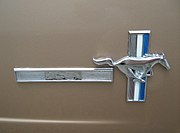


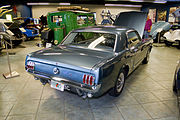

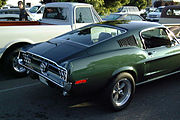

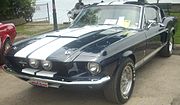



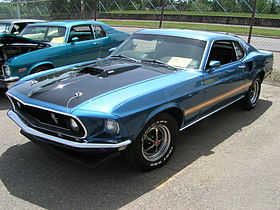
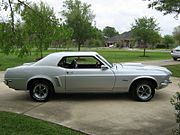
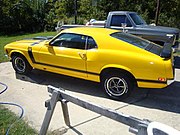

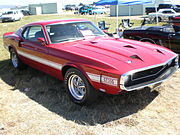


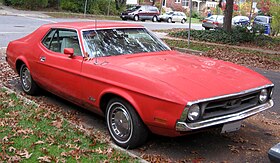





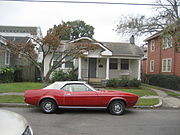



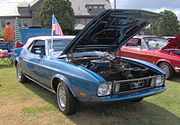

No comments:
Post a Comment